Group Dynamics and Teamwork: A Personal Reflection Report
VerifiedAdded on 2020/04/07
|9
|3110
|114
Report
AI Summary
This report presents a student's personal reflection on a group assignment, detailing their experiences with teamwork, collaboration, and the challenges encountered. The student initially expresses concerns about group work but finds success through effective communication and division of labor with teammates. The report discusses the stages of group formation, conflicts, and the eventual cohesion within the group. The student highlights the importance of similar approaches to problem-solving and the benefits of diverse working styles. Key aspects include the allocation of tasks, the development of a group contract, and the identification of personal strengths and weaknesses. The report also addresses the student's role in researching policy and social effects related to medical negligence, emphasizing the importance of stakeholder involvement. The student concludes with a sense of pride in the group's accomplishments and a recognition of the valuable lessons learned about teamwork and collaboration. The report also contains references to various sources used for research.
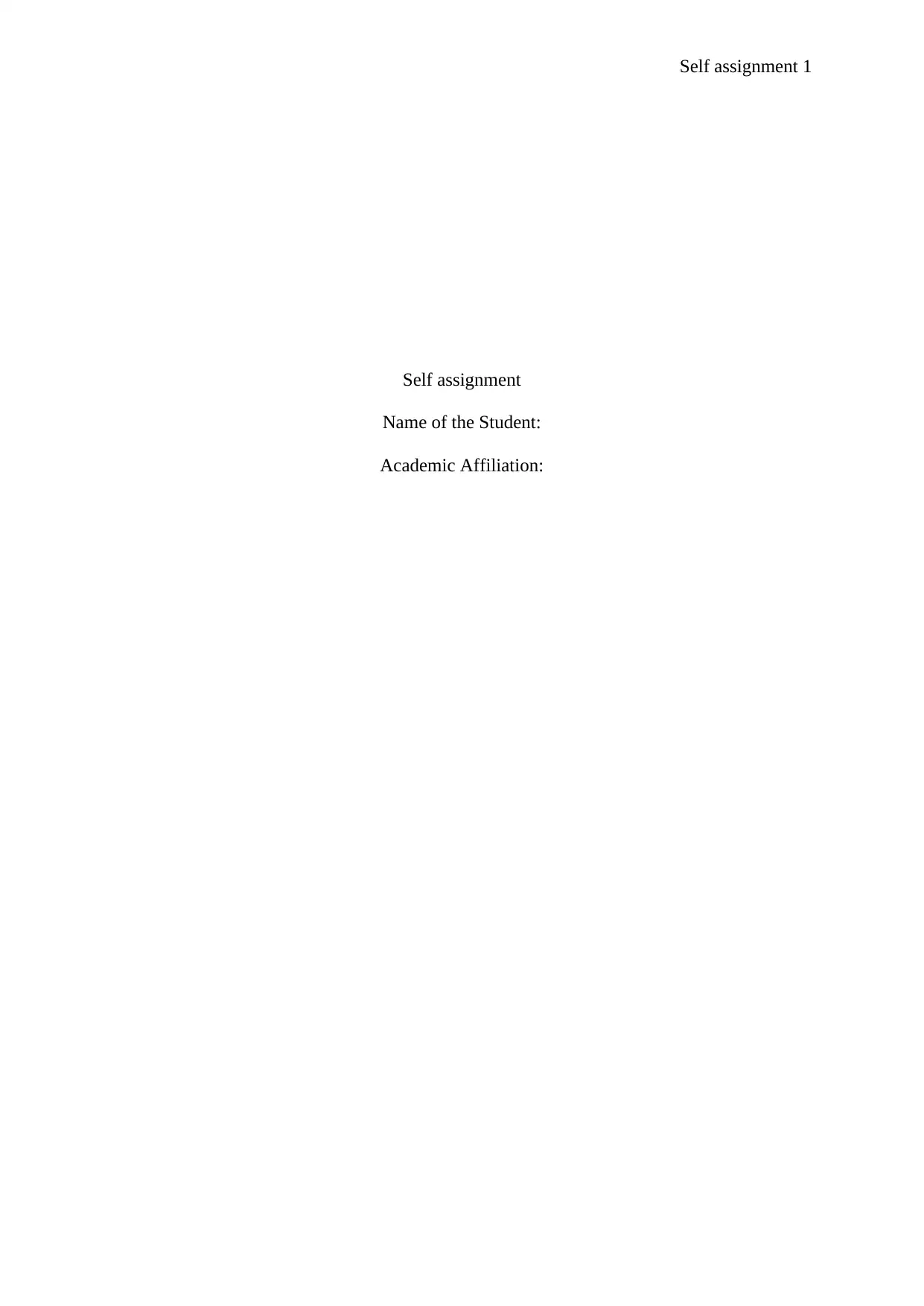
Self assignment 1
Self assignment
Name of the Student:
Academic Affiliation:
Self assignment
Name of the Student:
Academic Affiliation:
Paraphrase This Document
Need a fresh take? Get an instant paraphrase of this document with our AI Paraphraser
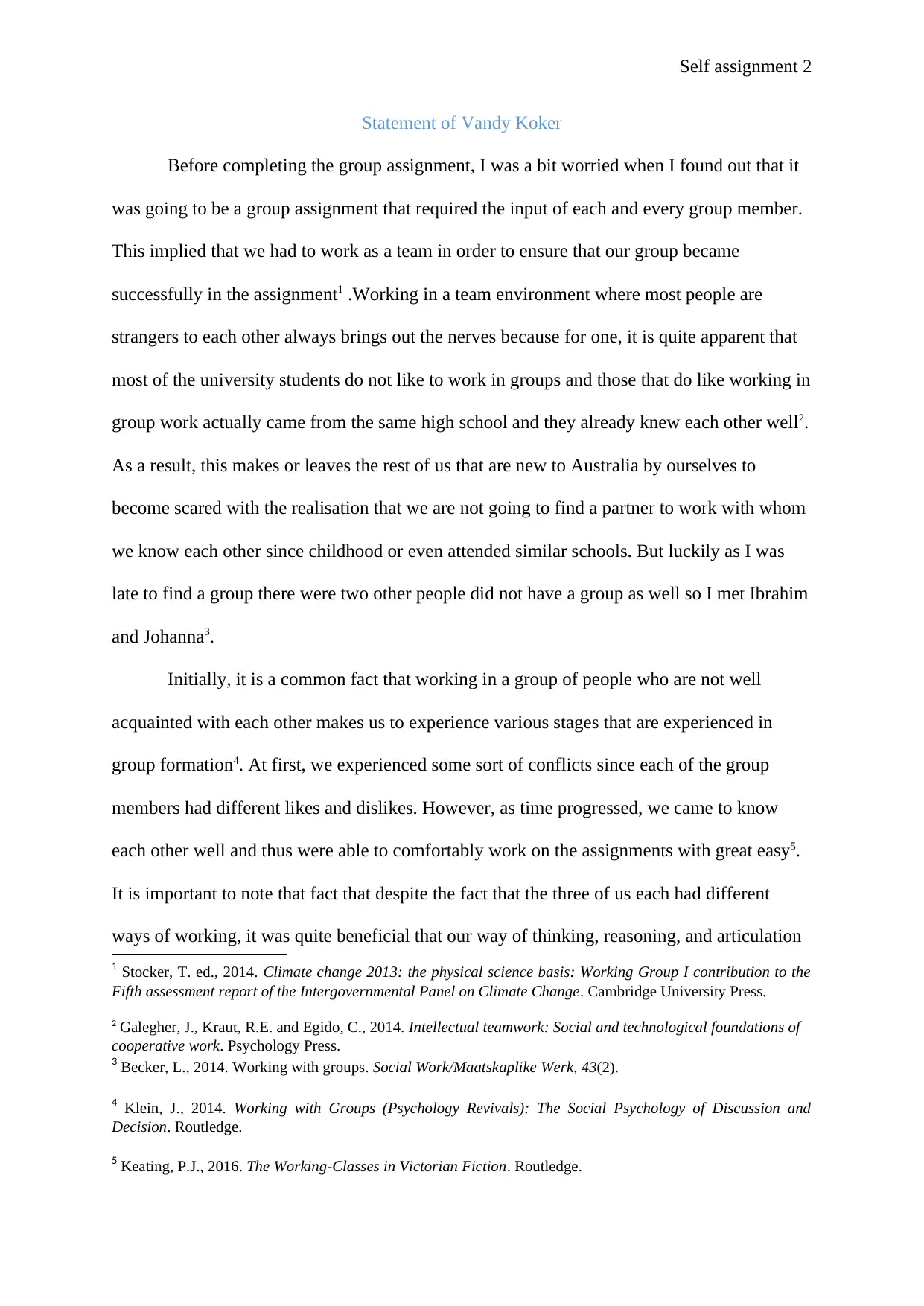
Self assignment 2
Statement of Vandy Koker
Before completing the group assignment, I was a bit worried when I found out that it
was going to be a group assignment that required the input of each and every group member.
This implied that we had to work as a team in order to ensure that our group became
successfully in the assignment1 .Working in a team environment where most people are
strangers to each other always brings out the nerves because for one, it is quite apparent that
most of the university students do not like to work in groups and those that do like working in
group work actually came from the same high school and they already knew each other well2.
As a result, this makes or leaves the rest of us that are new to Australia by ourselves to
become scared with the realisation that we are not going to find a partner to work with whom
we know each other since childhood or even attended similar schools. But luckily as I was
late to find a group there were two other people did not have a group as well so I met Ibrahim
and Johanna3.
Initially, it is a common fact that working in a group of people who are not well
acquainted with each other makes us to experience various stages that are experienced in
group formation4. At first, we experienced some sort of conflicts since each of the group
members had different likes and dislikes. However, as time progressed, we came to know
each other well and thus were able to comfortably work on the assignments with great easy5.
It is important to note that fact that despite the fact that the three of us each had different
ways of working, it was quite beneficial that our way of thinking, reasoning, and articulation
1 Stocker, T. ed., 2014. Climate change 2013: the physical science basis: Working Group I contribution to the
Fifth assessment report of the Intergovernmental Panel on Climate Change. Cambridge University Press.
2 Galegher, J., Kraut, R.E. and Egido, C., 2014. Intellectual teamwork: Social and technological foundations of
cooperative work. Psychology Press.
3 Becker, L., 2014. Working with groups. Social Work/Maatskaplike Werk, 43(2).
4 Klein, J., 2014. Working with Groups (Psychology Revivals): The Social Psychology of Discussion and
Decision. Routledge.
5 Keating, P.J., 2016. The Working-Classes in Victorian Fiction. Routledge.
Statement of Vandy Koker
Before completing the group assignment, I was a bit worried when I found out that it
was going to be a group assignment that required the input of each and every group member.
This implied that we had to work as a team in order to ensure that our group became
successfully in the assignment1 .Working in a team environment where most people are
strangers to each other always brings out the nerves because for one, it is quite apparent that
most of the university students do not like to work in groups and those that do like working in
group work actually came from the same high school and they already knew each other well2.
As a result, this makes or leaves the rest of us that are new to Australia by ourselves to
become scared with the realisation that we are not going to find a partner to work with whom
we know each other since childhood or even attended similar schools. But luckily as I was
late to find a group there were two other people did not have a group as well so I met Ibrahim
and Johanna3.
Initially, it is a common fact that working in a group of people who are not well
acquainted with each other makes us to experience various stages that are experienced in
group formation4. At first, we experienced some sort of conflicts since each of the group
members had different likes and dislikes. However, as time progressed, we came to know
each other well and thus were able to comfortably work on the assignments with great easy5.
It is important to note that fact that despite the fact that the three of us each had different
ways of working, it was quite beneficial that our way of thinking, reasoning, and articulation
1 Stocker, T. ed., 2014. Climate change 2013: the physical science basis: Working Group I contribution to the
Fifth assessment report of the Intergovernmental Panel on Climate Change. Cambridge University Press.
2 Galegher, J., Kraut, R.E. and Egido, C., 2014. Intellectual teamwork: Social and technological foundations of
cooperative work. Psychology Press.
3 Becker, L., 2014. Working with groups. Social Work/Maatskaplike Werk, 43(2).
4 Klein, J., 2014. Working with Groups (Psychology Revivals): The Social Psychology of Discussion and
Decision. Routledge.
5 Keating, P.J., 2016. The Working-Classes in Victorian Fiction. Routledge.
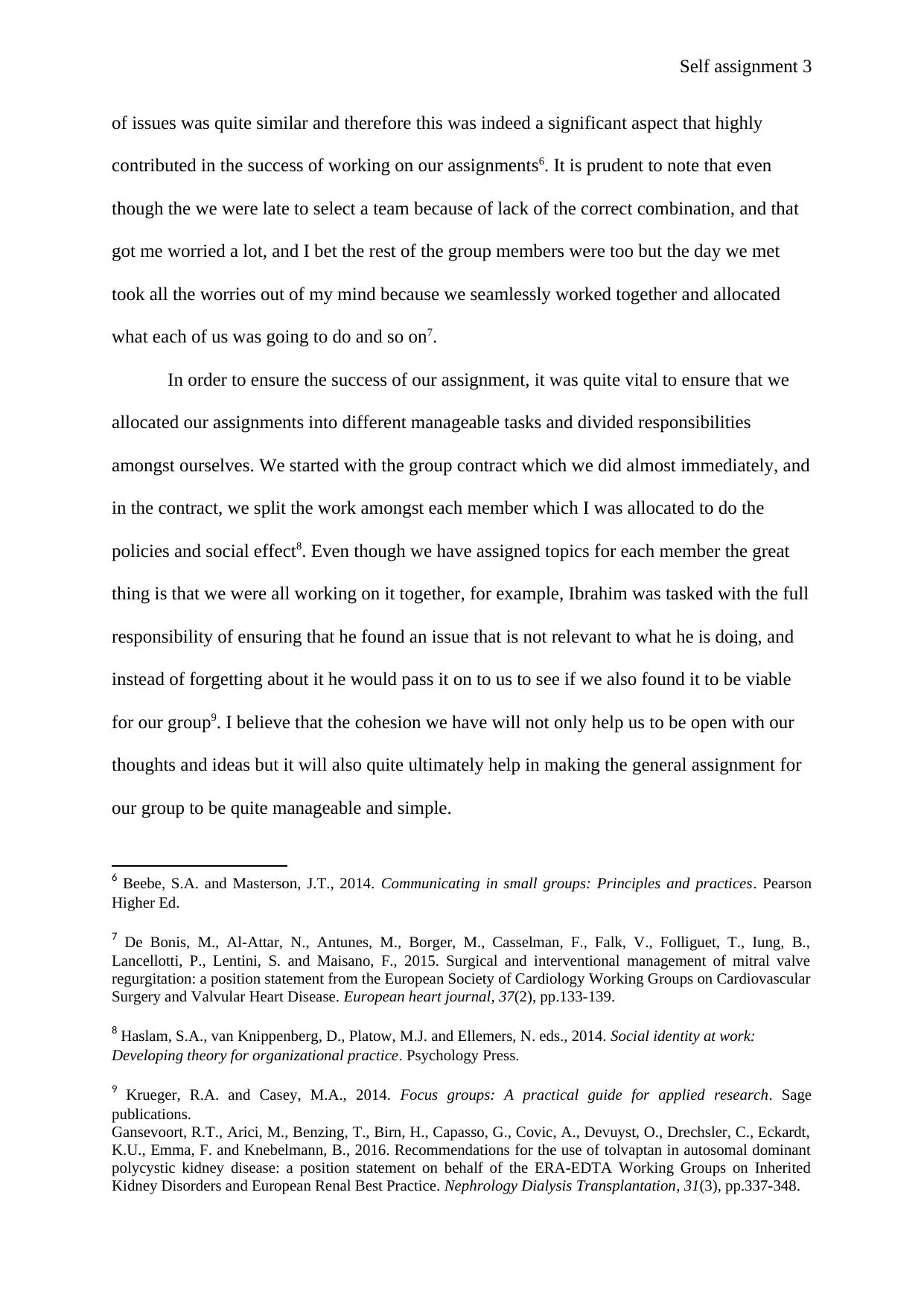
Self assignment 3
of issues was quite similar and therefore this was indeed a significant aspect that highly
contributed in the success of working on our assignments6. It is prudent to note that even
though the we were late to select a team because of lack of the correct combination, and that
got me worried a lot, and I bet the rest of the group members were too but the day we met
took all the worries out of my mind because we seamlessly worked together and allocated
what each of us was going to do and so on7.
In order to ensure the success of our assignment, it was quite vital to ensure that we
allocated our assignments into different manageable tasks and divided responsibilities
amongst ourselves. We started with the group contract which we did almost immediately, and
in the contract, we split the work amongst each member which I was allocated to do the
policies and social effect8. Even though we have assigned topics for each member the great
thing is that we were all working on it together, for example, Ibrahim was tasked with the full
responsibility of ensuring that he found an issue that is not relevant to what he is doing, and
instead of forgetting about it he would pass it on to us to see if we also found it to be viable
for our group9. I believe that the cohesion we have will not only help us to be open with our
thoughts and ideas but it will also quite ultimately help in making the general assignment for
our group to be quite manageable and simple.
6 Beebe, S.A. and Masterson, J.T., 2014. Communicating in small groups: Principles and practices. Pearson
Higher Ed.
7 De Bonis, M., Al-Attar, N., Antunes, M., Borger, M., Casselman, F., Falk, V., Folliguet, T., Iung, B.,
Lancellotti, P., Lentini, S. and Maisano, F., 2015. Surgical and interventional management of mitral valve
regurgitation: a position statement from the European Society of Cardiology Working Groups on Cardiovascular
Surgery and Valvular Heart Disease. European heart journal, 37(2), pp.133-139.
8 Haslam, S.A., van Knippenberg, D., Platow, M.J. and Ellemers, N. eds., 2014. Social identity at work:
Developing theory for organizational practice. Psychology Press.
9 Krueger, R.A. and Casey, M.A., 2014. Focus groups: A practical guide for applied research. Sage
publications.
Gansevoort, R.T., Arici, M., Benzing, T., Birn, H., Capasso, G., Covic, A., Devuyst, O., Drechsler, C., Eckardt,
K.U., Emma, F. and Knebelmann, B., 2016. Recommendations for the use of tolvaptan in autosomal dominant
polycystic kidney disease: a position statement on behalf of the ERA-EDTA Working Groups on Inherited
Kidney Disorders and European Renal Best Practice. Nephrology Dialysis Transplantation, 31(3), pp.337-348.
of issues was quite similar and therefore this was indeed a significant aspect that highly
contributed in the success of working on our assignments6. It is prudent to note that even
though the we were late to select a team because of lack of the correct combination, and that
got me worried a lot, and I bet the rest of the group members were too but the day we met
took all the worries out of my mind because we seamlessly worked together and allocated
what each of us was going to do and so on7.
In order to ensure the success of our assignment, it was quite vital to ensure that we
allocated our assignments into different manageable tasks and divided responsibilities
amongst ourselves. We started with the group contract which we did almost immediately, and
in the contract, we split the work amongst each member which I was allocated to do the
policies and social effect8. Even though we have assigned topics for each member the great
thing is that we were all working on it together, for example, Ibrahim was tasked with the full
responsibility of ensuring that he found an issue that is not relevant to what he is doing, and
instead of forgetting about it he would pass it on to us to see if we also found it to be viable
for our group9. I believe that the cohesion we have will not only help us to be open with our
thoughts and ideas but it will also quite ultimately help in making the general assignment for
our group to be quite manageable and simple.
6 Beebe, S.A. and Masterson, J.T., 2014. Communicating in small groups: Principles and practices. Pearson
Higher Ed.
7 De Bonis, M., Al-Attar, N., Antunes, M., Borger, M., Casselman, F., Falk, V., Folliguet, T., Iung, B.,
Lancellotti, P., Lentini, S. and Maisano, F., 2015. Surgical and interventional management of mitral valve
regurgitation: a position statement from the European Society of Cardiology Working Groups on Cardiovascular
Surgery and Valvular Heart Disease. European heart journal, 37(2), pp.133-139.
8 Haslam, S.A., van Knippenberg, D., Platow, M.J. and Ellemers, N. eds., 2014. Social identity at work:
Developing theory for organizational practice. Psychology Press.
9 Krueger, R.A. and Casey, M.A., 2014. Focus groups: A practical guide for applied research. Sage
publications.
Gansevoort, R.T., Arici, M., Benzing, T., Birn, H., Capasso, G., Covic, A., Devuyst, O., Drechsler, C., Eckardt,
K.U., Emma, F. and Knebelmann, B., 2016. Recommendations for the use of tolvaptan in autosomal dominant
polycystic kidney disease: a position statement on behalf of the ERA-EDTA Working Groups on Inherited
Kidney Disorders and European Renal Best Practice. Nephrology Dialysis Transplantation, 31(3), pp.337-348.
⊘ This is a preview!⊘
Do you want full access?
Subscribe today to unlock all pages.

Trusted by 1+ million students worldwide
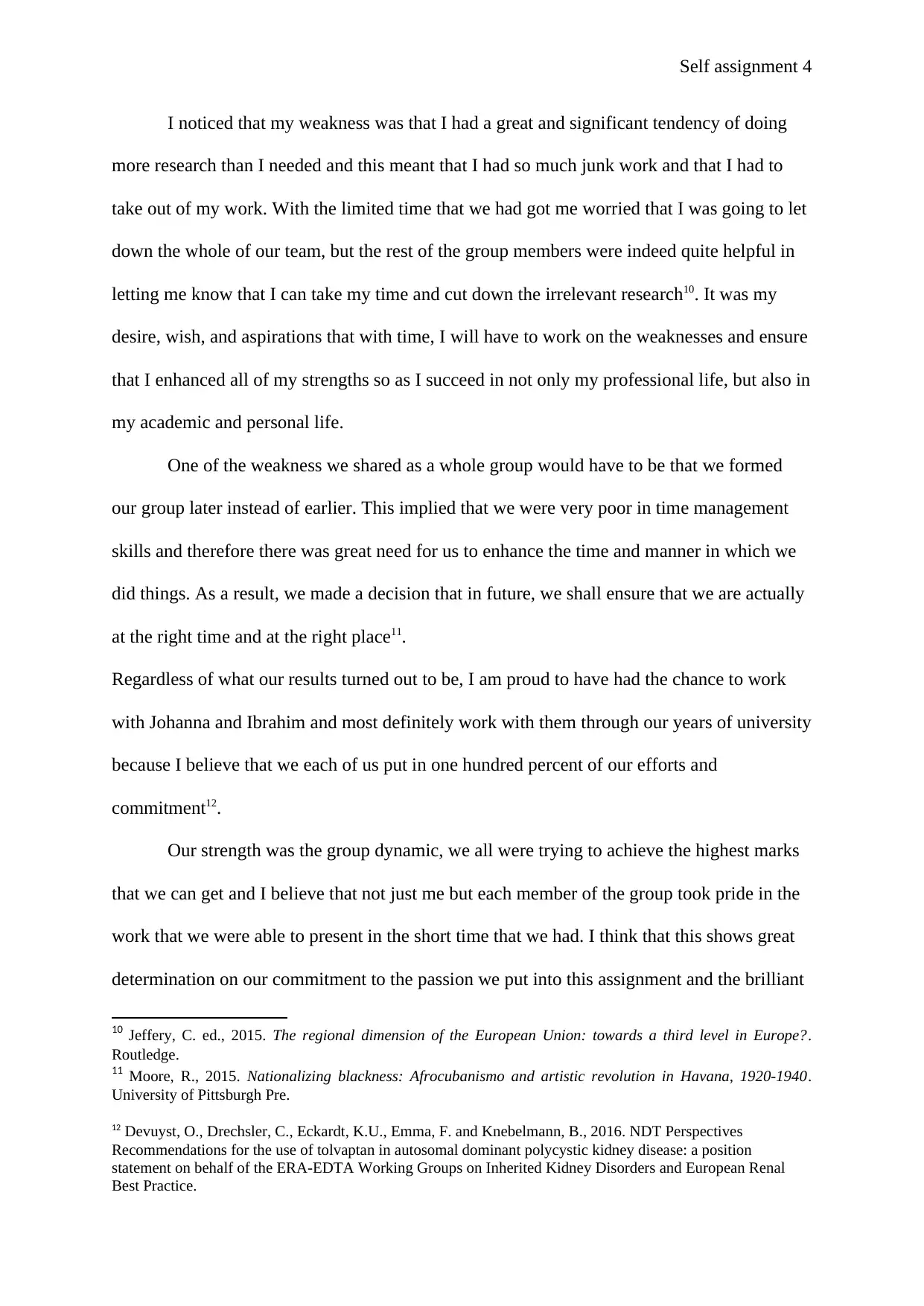
Self assignment 4
I noticed that my weakness was that I had a great and significant tendency of doing
more research than I needed and this meant that I had so much junk work and that I had to
take out of my work. With the limited time that we had got me worried that I was going to let
down the whole of our team, but the rest of the group members were indeed quite helpful in
letting me know that I can take my time and cut down the irrelevant research10. It was my
desire, wish, and aspirations that with time, I will have to work on the weaknesses and ensure
that I enhanced all of my strengths so as I succeed in not only my professional life, but also in
my academic and personal life.
One of the weakness we shared as a whole group would have to be that we formed
our group later instead of earlier. This implied that we were very poor in time management
skills and therefore there was great need for us to enhance the time and manner in which we
did things. As a result, we made a decision that in future, we shall ensure that we are actually
at the right time and at the right place11.
Regardless of what our results turned out to be, I am proud to have had the chance to work
with Johanna and Ibrahim and most definitely work with them through our years of university
because I believe that we each of us put in one hundred percent of our efforts and
commitment12.
Our strength was the group dynamic, we all were trying to achieve the highest marks
that we can get and I believe that not just me but each member of the group took pride in the
work that we were able to present in the short time that we had. I think that this shows great
determination on our commitment to the passion we put into this assignment and the brilliant
10 Jeffery, C. ed., 2015. The regional dimension of the European Union: towards a third level in Europe?.
Routledge.
11 Moore, R., 2015. Nationalizing blackness: Afrocubanismo and artistic revolution in Havana, 1920-1940.
University of Pittsburgh Pre.
12 Devuyst, O., Drechsler, C., Eckardt, K.U., Emma, F. and Knebelmann, B., 2016. NDT Perspectives
Recommendations for the use of tolvaptan in autosomal dominant polycystic kidney disease: a position
statement on behalf of the ERA-EDTA Working Groups on Inherited Kidney Disorders and European Renal
Best Practice.
I noticed that my weakness was that I had a great and significant tendency of doing
more research than I needed and this meant that I had so much junk work and that I had to
take out of my work. With the limited time that we had got me worried that I was going to let
down the whole of our team, but the rest of the group members were indeed quite helpful in
letting me know that I can take my time and cut down the irrelevant research10. It was my
desire, wish, and aspirations that with time, I will have to work on the weaknesses and ensure
that I enhanced all of my strengths so as I succeed in not only my professional life, but also in
my academic and personal life.
One of the weakness we shared as a whole group would have to be that we formed
our group later instead of earlier. This implied that we were very poor in time management
skills and therefore there was great need for us to enhance the time and manner in which we
did things. As a result, we made a decision that in future, we shall ensure that we are actually
at the right time and at the right place11.
Regardless of what our results turned out to be, I am proud to have had the chance to work
with Johanna and Ibrahim and most definitely work with them through our years of university
because I believe that we each of us put in one hundred percent of our efforts and
commitment12.
Our strength was the group dynamic, we all were trying to achieve the highest marks
that we can get and I believe that not just me but each member of the group took pride in the
work that we were able to present in the short time that we had. I think that this shows great
determination on our commitment to the passion we put into this assignment and the brilliant
10 Jeffery, C. ed., 2015. The regional dimension of the European Union: towards a third level in Europe?.
Routledge.
11 Moore, R., 2015. Nationalizing blackness: Afrocubanismo and artistic revolution in Havana, 1920-1940.
University of Pittsburgh Pre.
12 Devuyst, O., Drechsler, C., Eckardt, K.U., Emma, F. and Knebelmann, B., 2016. NDT Perspectives
Recommendations for the use of tolvaptan in autosomal dominant polycystic kidney disease: a position
statement on behalf of the ERA-EDTA Working Groups on Inherited Kidney Disorders and European Renal
Best Practice.
Paraphrase This Document
Need a fresh take? Get an instant paraphrase of this document with our AI Paraphraser
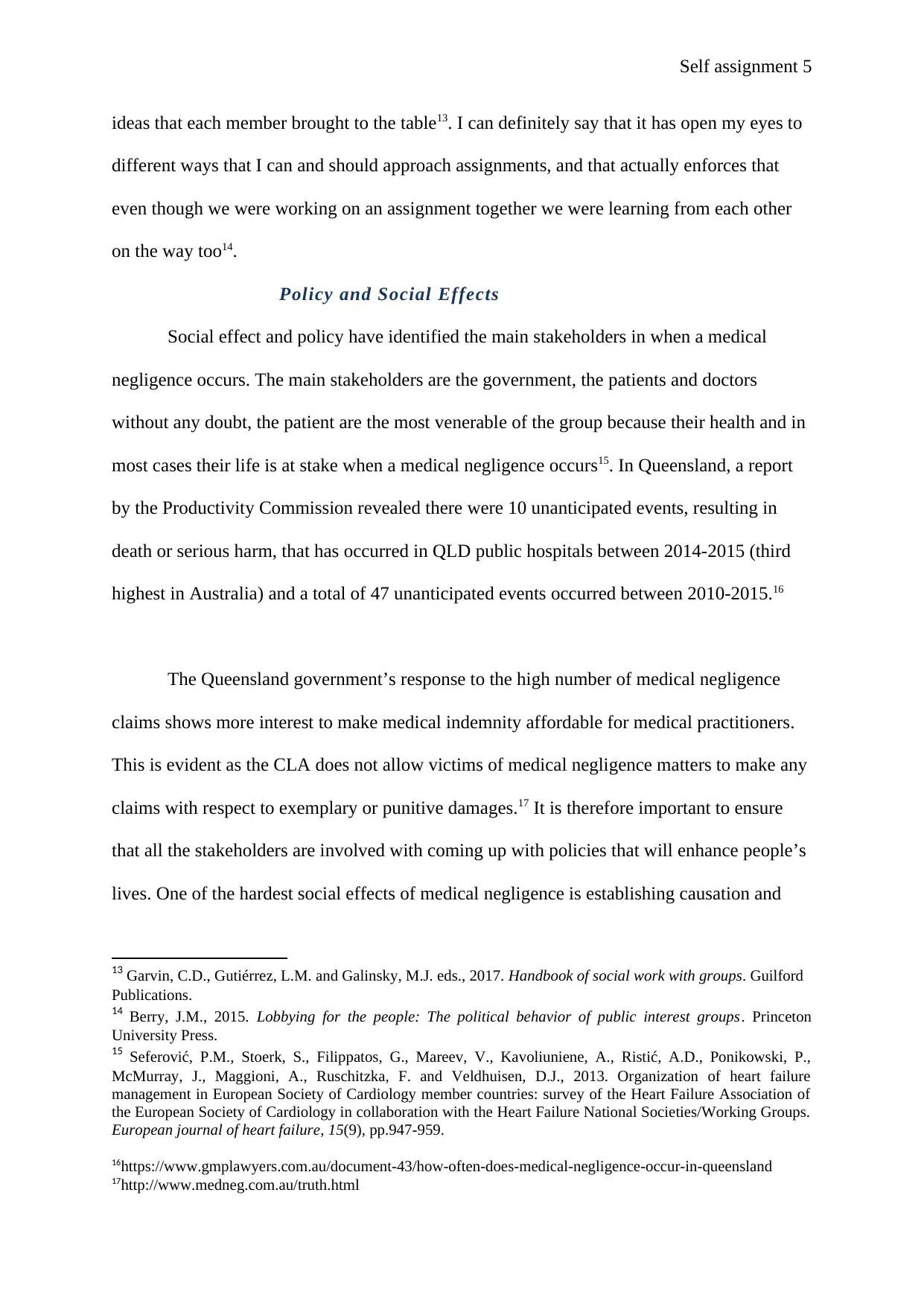
Self assignment 5
ideas that each member brought to the table13. I can definitely say that it has open my eyes to
different ways that I can and should approach assignments, and that actually enforces that
even though we were working on an assignment together we were learning from each other
on the way too14.
Policy and Social Effects
Social effect and policy have identified the main stakeholders in when a medical
negligence occurs. The main stakeholders are the government, the patients and doctors
without any doubt, the patient are the most venerable of the group because their health and in
most cases their life is at stake when a medical negligence occurs15. In Queensland, a report
by the Productivity Commission revealed there were 10 unanticipated events, resulting in
death or serious harm, that has occurred in QLD public hospitals between 2014-2015 (third
highest in Australia) and a total of 47 unanticipated events occurred between 2010-2015.16
The Queensland government’s response to the high number of medical negligence
claims shows more interest to make medical indemnity affordable for medical practitioners.
This is evident as the CLA does not allow victims of medical negligence matters to make any
claims with respect to exemplary or punitive damages.17 It is therefore important to ensure
that all the stakeholders are involved with coming up with policies that will enhance people’s
lives. One of the hardest social effects of medical negligence is establishing causation and
13 Garvin, C.D., Gutiérrez, L.M. and Galinsky, M.J. eds., 2017. Handbook of social work with groups. Guilford
Publications.
14 Berry, J.M., 2015. Lobbying for the people: The political behavior of public interest groups. Princeton
University Press.
15 Seferović, P.M., Stoerk, S., Filippatos, G., Mareev, V., Kavoliuniene, A., Ristić, A.D., Ponikowski, P.,
McMurray, J., Maggioni, A., Ruschitzka, F. and Veldhuisen, D.J., 2013. Organization of heart failure
management in European Society of Cardiology member countries: survey of the Heart Failure Association of
the European Society of Cardiology in collaboration with the Heart Failure National Societies/Working Groups.
European journal of heart failure, 15(9), pp.947-959.
16https://www.gmplawyers.com.au/document-43/how-often-does-medical-negligence-occur-in-queensland
17http://www.medneg.com.au/truth.html
ideas that each member brought to the table13. I can definitely say that it has open my eyes to
different ways that I can and should approach assignments, and that actually enforces that
even though we were working on an assignment together we were learning from each other
on the way too14.
Policy and Social Effects
Social effect and policy have identified the main stakeholders in when a medical
negligence occurs. The main stakeholders are the government, the patients and doctors
without any doubt, the patient are the most venerable of the group because their health and in
most cases their life is at stake when a medical negligence occurs15. In Queensland, a report
by the Productivity Commission revealed there were 10 unanticipated events, resulting in
death or serious harm, that has occurred in QLD public hospitals between 2014-2015 (third
highest in Australia) and a total of 47 unanticipated events occurred between 2010-2015.16
The Queensland government’s response to the high number of medical negligence
claims shows more interest to make medical indemnity affordable for medical practitioners.
This is evident as the CLA does not allow victims of medical negligence matters to make any
claims with respect to exemplary or punitive damages.17 It is therefore important to ensure
that all the stakeholders are involved with coming up with policies that will enhance people’s
lives. One of the hardest social effects of medical negligence is establishing causation and
13 Garvin, C.D., Gutiérrez, L.M. and Galinsky, M.J. eds., 2017. Handbook of social work with groups. Guilford
Publications.
14 Berry, J.M., 2015. Lobbying for the people: The political behavior of public interest groups. Princeton
University Press.
15 Seferović, P.M., Stoerk, S., Filippatos, G., Mareev, V., Kavoliuniene, A., Ristić, A.D., Ponikowski, P.,
McMurray, J., Maggioni, A., Ruschitzka, F. and Veldhuisen, D.J., 2013. Organization of heart failure
management in European Society of Cardiology member countries: survey of the Heart Failure Association of
the European Society of Cardiology in collaboration with the Heart Failure National Societies/Working Groups.
European journal of heart failure, 15(9), pp.947-959.
16https://www.gmplawyers.com.au/document-43/how-often-does-medical-negligence-occur-in-queensland
17http://www.medneg.com.au/truth.html
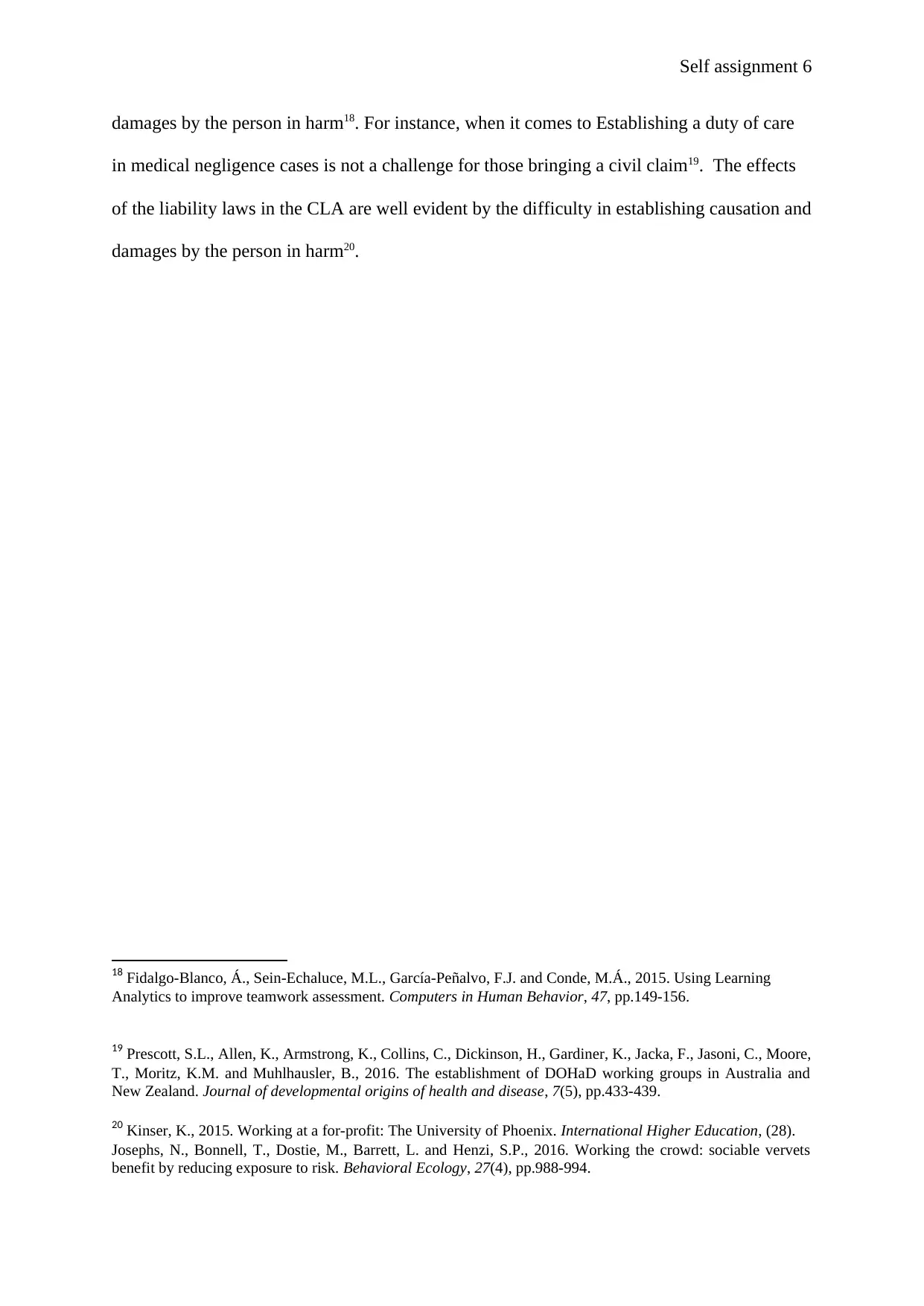
Self assignment 6
damages by the person in harm18. For instance, when it comes to Establishing a duty of care
in medical negligence cases is not a challenge for those bringing a civil claim19. The effects
of the liability laws in the CLA are well evident by the difficulty in establishing causation and
damages by the person in harm20.
18 Fidalgo-Blanco, Á., Sein-Echaluce, M.L., García-Peñalvo, F.J. and Conde, M.Á., 2015. Using Learning
Analytics to improve teamwork assessment. Computers in Human Behavior, 47, pp.149-156.
19 Prescott, S.L., Allen, K., Armstrong, K., Collins, C., Dickinson, H., Gardiner, K., Jacka, F., Jasoni, C., Moore,
T., Moritz, K.M. and Muhlhausler, B., 2016. The establishment of DOHaD working groups in Australia and
New Zealand. Journal of developmental origins of health and disease, 7(5), pp.433-439.
20 Kinser, K., 2015. Working at a for-profit: The University of Phoenix. International Higher Education, (28).
Josephs, N., Bonnell, T., Dostie, M., Barrett, L. and Henzi, S.P., 2016. Working the crowd: sociable vervets
benefit by reducing exposure to risk. Behavioral Ecology, 27(4), pp.988-994.
damages by the person in harm18. For instance, when it comes to Establishing a duty of care
in medical negligence cases is not a challenge for those bringing a civil claim19. The effects
of the liability laws in the CLA are well evident by the difficulty in establishing causation and
damages by the person in harm20.
18 Fidalgo-Blanco, Á., Sein-Echaluce, M.L., García-Peñalvo, F.J. and Conde, M.Á., 2015. Using Learning
Analytics to improve teamwork assessment. Computers in Human Behavior, 47, pp.149-156.
19 Prescott, S.L., Allen, K., Armstrong, K., Collins, C., Dickinson, H., Gardiner, K., Jacka, F., Jasoni, C., Moore,
T., Moritz, K.M. and Muhlhausler, B., 2016. The establishment of DOHaD working groups in Australia and
New Zealand. Journal of developmental origins of health and disease, 7(5), pp.433-439.
20 Kinser, K., 2015. Working at a for-profit: The University of Phoenix. International Higher Education, (28).
Josephs, N., Bonnell, T., Dostie, M., Barrett, L. and Henzi, S.P., 2016. Working the crowd: sociable vervets
benefit by reducing exposure to risk. Behavioral Ecology, 27(4), pp.988-994.
⊘ This is a preview!⊘
Do you want full access?
Subscribe today to unlock all pages.

Trusted by 1+ million students worldwide
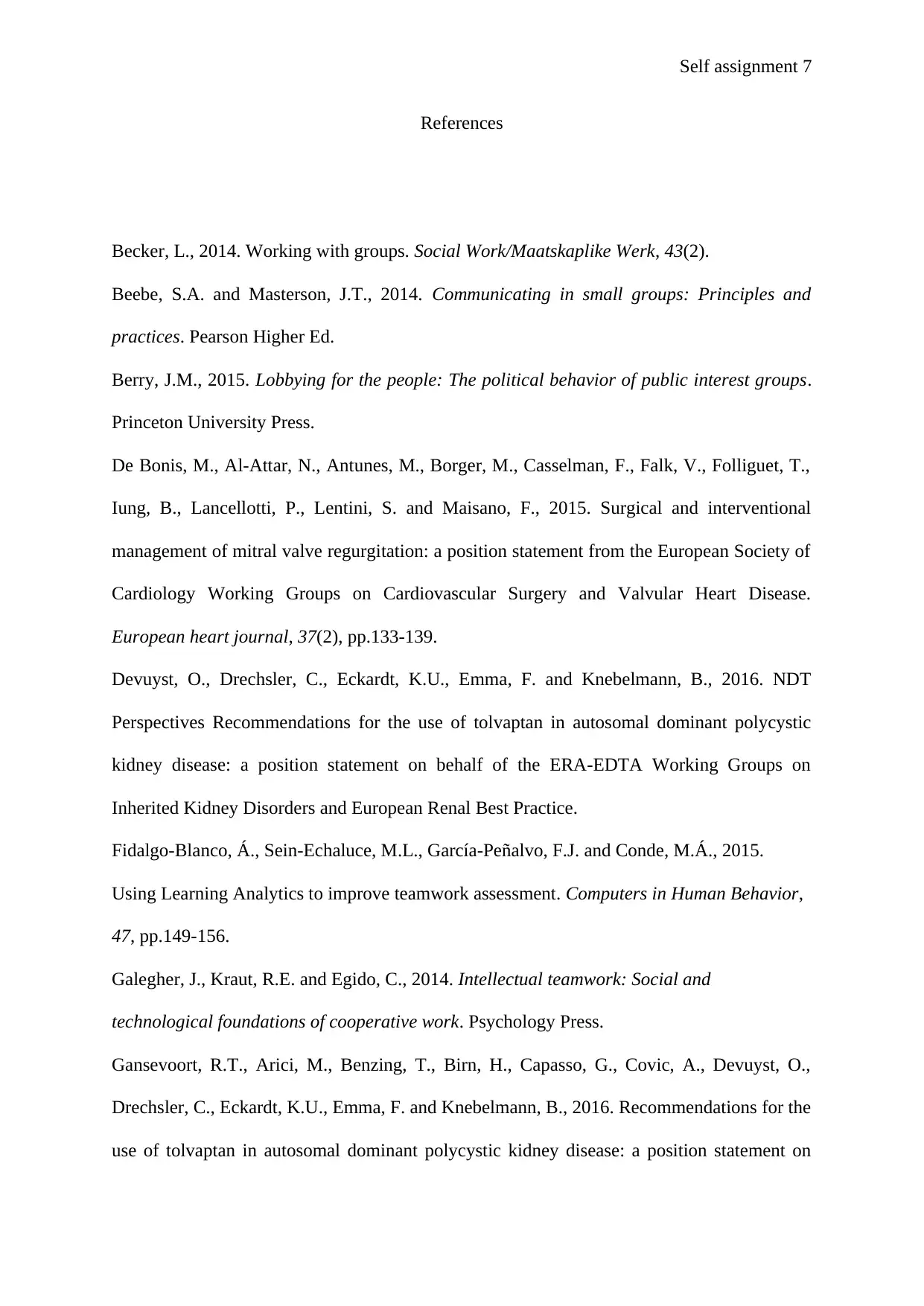
Self assignment 7
References
Becker, L., 2014. Working with groups. Social Work/Maatskaplike Werk, 43(2).
Beebe, S.A. and Masterson, J.T., 2014. Communicating in small groups: Principles and
practices. Pearson Higher Ed.
Berry, J.M., 2015. Lobbying for the people: The political behavior of public interest groups.
Princeton University Press.
De Bonis, M., Al-Attar, N., Antunes, M., Borger, M., Casselman, F., Falk, V., Folliguet, T.,
Iung, B., Lancellotti, P., Lentini, S. and Maisano, F., 2015. Surgical and interventional
management of mitral valve regurgitation: a position statement from the European Society of
Cardiology Working Groups on Cardiovascular Surgery and Valvular Heart Disease.
European heart journal, 37(2), pp.133-139.
Devuyst, O., Drechsler, C., Eckardt, K.U., Emma, F. and Knebelmann, B., 2016. NDT
Perspectives Recommendations for the use of tolvaptan in autosomal dominant polycystic
kidney disease: a position statement on behalf of the ERA-EDTA Working Groups on
Inherited Kidney Disorders and European Renal Best Practice.
Fidalgo-Blanco, Á., Sein-Echaluce, M.L., García-Peñalvo, F.J. and Conde, M.Á., 2015.
Using Learning Analytics to improve teamwork assessment. Computers in Human Behavior,
47, pp.149-156.
Galegher, J., Kraut, R.E. and Egido, C., 2014. Intellectual teamwork: Social and
technological foundations of cooperative work. Psychology Press.
Gansevoort, R.T., Arici, M., Benzing, T., Birn, H., Capasso, G., Covic, A., Devuyst, O.,
Drechsler, C., Eckardt, K.U., Emma, F. and Knebelmann, B., 2016. Recommendations for the
use of tolvaptan in autosomal dominant polycystic kidney disease: a position statement on
References
Becker, L., 2014. Working with groups. Social Work/Maatskaplike Werk, 43(2).
Beebe, S.A. and Masterson, J.T., 2014. Communicating in small groups: Principles and
practices. Pearson Higher Ed.
Berry, J.M., 2015. Lobbying for the people: The political behavior of public interest groups.
Princeton University Press.
De Bonis, M., Al-Attar, N., Antunes, M., Borger, M., Casselman, F., Falk, V., Folliguet, T.,
Iung, B., Lancellotti, P., Lentini, S. and Maisano, F., 2015. Surgical and interventional
management of mitral valve regurgitation: a position statement from the European Society of
Cardiology Working Groups on Cardiovascular Surgery and Valvular Heart Disease.
European heart journal, 37(2), pp.133-139.
Devuyst, O., Drechsler, C., Eckardt, K.U., Emma, F. and Knebelmann, B., 2016. NDT
Perspectives Recommendations for the use of tolvaptan in autosomal dominant polycystic
kidney disease: a position statement on behalf of the ERA-EDTA Working Groups on
Inherited Kidney Disorders and European Renal Best Practice.
Fidalgo-Blanco, Á., Sein-Echaluce, M.L., García-Peñalvo, F.J. and Conde, M.Á., 2015.
Using Learning Analytics to improve teamwork assessment. Computers in Human Behavior,
47, pp.149-156.
Galegher, J., Kraut, R.E. and Egido, C., 2014. Intellectual teamwork: Social and
technological foundations of cooperative work. Psychology Press.
Gansevoort, R.T., Arici, M., Benzing, T., Birn, H., Capasso, G., Covic, A., Devuyst, O.,
Drechsler, C., Eckardt, K.U., Emma, F. and Knebelmann, B., 2016. Recommendations for the
use of tolvaptan in autosomal dominant polycystic kidney disease: a position statement on
Paraphrase This Document
Need a fresh take? Get an instant paraphrase of this document with our AI Paraphraser
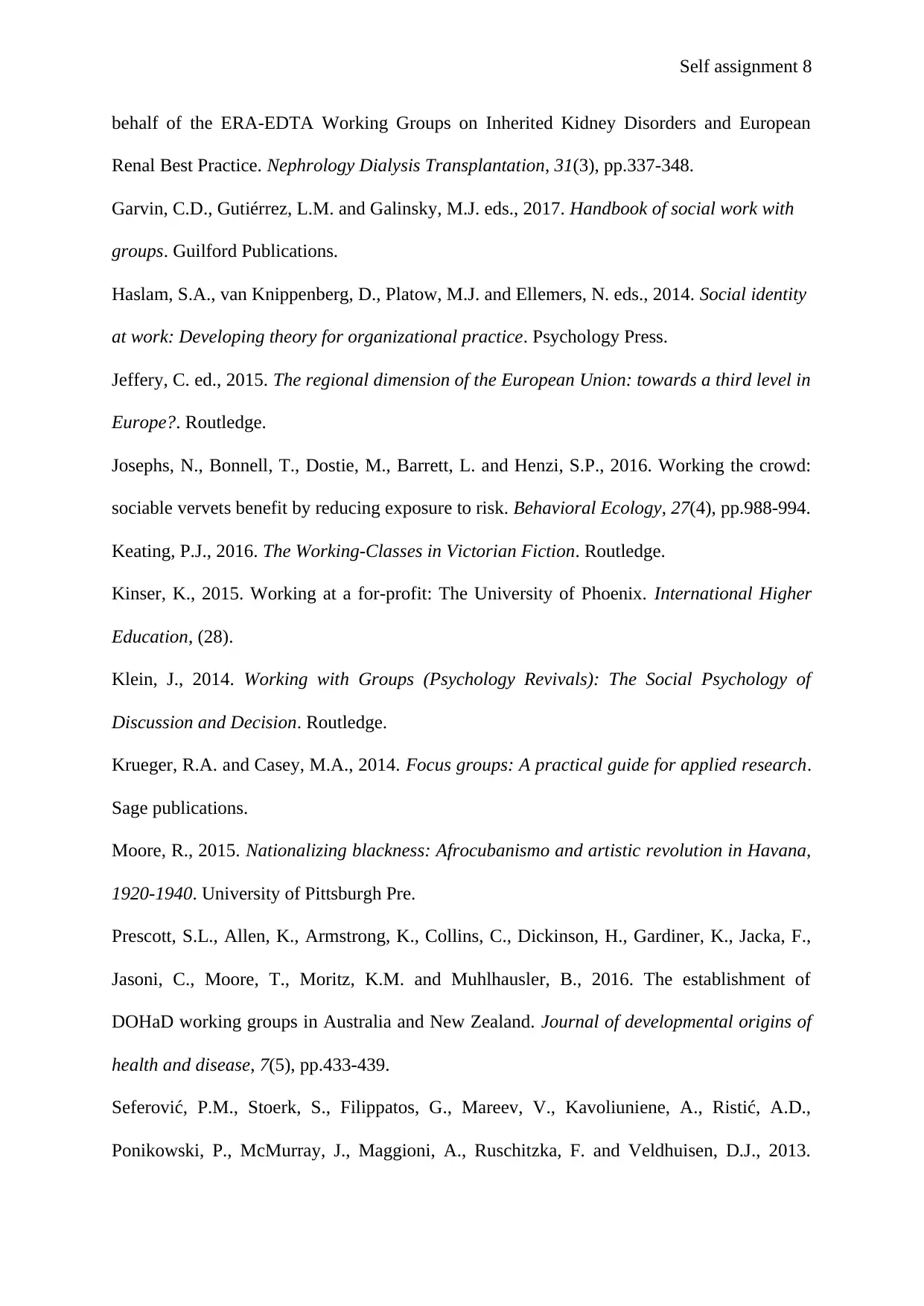
Self assignment 8
behalf of the ERA-EDTA Working Groups on Inherited Kidney Disorders and European
Renal Best Practice. Nephrology Dialysis Transplantation, 31(3), pp.337-348.
Garvin, C.D., Gutiérrez, L.M. and Galinsky, M.J. eds., 2017. Handbook of social work with
groups. Guilford Publications.
Haslam, S.A., van Knippenberg, D., Platow, M.J. and Ellemers, N. eds., 2014. Social identity
at work: Developing theory for organizational practice. Psychology Press.
Jeffery, C. ed., 2015. The regional dimension of the European Union: towards a third level in
Europe?. Routledge.
Josephs, N., Bonnell, T., Dostie, M., Barrett, L. and Henzi, S.P., 2016. Working the crowd:
sociable vervets benefit by reducing exposure to risk. Behavioral Ecology, 27(4), pp.988-994.
Keating, P.J., 2016. The Working-Classes in Victorian Fiction. Routledge.
Kinser, K., 2015. Working at a for-profit: The University of Phoenix. International Higher
Education, (28).
Klein, J., 2014. Working with Groups (Psychology Revivals): The Social Psychology of
Discussion and Decision. Routledge.
Krueger, R.A. and Casey, M.A., 2014. Focus groups: A practical guide for applied research.
Sage publications.
Moore, R., 2015. Nationalizing blackness: Afrocubanismo and artistic revolution in Havana,
1920-1940. University of Pittsburgh Pre.
Prescott, S.L., Allen, K., Armstrong, K., Collins, C., Dickinson, H., Gardiner, K., Jacka, F.,
Jasoni, C., Moore, T., Moritz, K.M. and Muhlhausler, B., 2016. The establishment of
DOHaD working groups in Australia and New Zealand. Journal of developmental origins of
health and disease, 7(5), pp.433-439.
Seferović, P.M., Stoerk, S., Filippatos, G., Mareev, V., Kavoliuniene, A., Ristić, A.D.,
Ponikowski, P., McMurray, J., Maggioni, A., Ruschitzka, F. and Veldhuisen, D.J., 2013.
behalf of the ERA-EDTA Working Groups on Inherited Kidney Disorders and European
Renal Best Practice. Nephrology Dialysis Transplantation, 31(3), pp.337-348.
Garvin, C.D., Gutiérrez, L.M. and Galinsky, M.J. eds., 2017. Handbook of social work with
groups. Guilford Publications.
Haslam, S.A., van Knippenberg, D., Platow, M.J. and Ellemers, N. eds., 2014. Social identity
at work: Developing theory for organizational practice. Psychology Press.
Jeffery, C. ed., 2015. The regional dimension of the European Union: towards a third level in
Europe?. Routledge.
Josephs, N., Bonnell, T., Dostie, M., Barrett, L. and Henzi, S.P., 2016. Working the crowd:
sociable vervets benefit by reducing exposure to risk. Behavioral Ecology, 27(4), pp.988-994.
Keating, P.J., 2016. The Working-Classes in Victorian Fiction. Routledge.
Kinser, K., 2015. Working at a for-profit: The University of Phoenix. International Higher
Education, (28).
Klein, J., 2014. Working with Groups (Psychology Revivals): The Social Psychology of
Discussion and Decision. Routledge.
Krueger, R.A. and Casey, M.A., 2014. Focus groups: A practical guide for applied research.
Sage publications.
Moore, R., 2015. Nationalizing blackness: Afrocubanismo and artistic revolution in Havana,
1920-1940. University of Pittsburgh Pre.
Prescott, S.L., Allen, K., Armstrong, K., Collins, C., Dickinson, H., Gardiner, K., Jacka, F.,
Jasoni, C., Moore, T., Moritz, K.M. and Muhlhausler, B., 2016. The establishment of
DOHaD working groups in Australia and New Zealand. Journal of developmental origins of
health and disease, 7(5), pp.433-439.
Seferović, P.M., Stoerk, S., Filippatos, G., Mareev, V., Kavoliuniene, A., Ristić, A.D.,
Ponikowski, P., McMurray, J., Maggioni, A., Ruschitzka, F. and Veldhuisen, D.J., 2013.
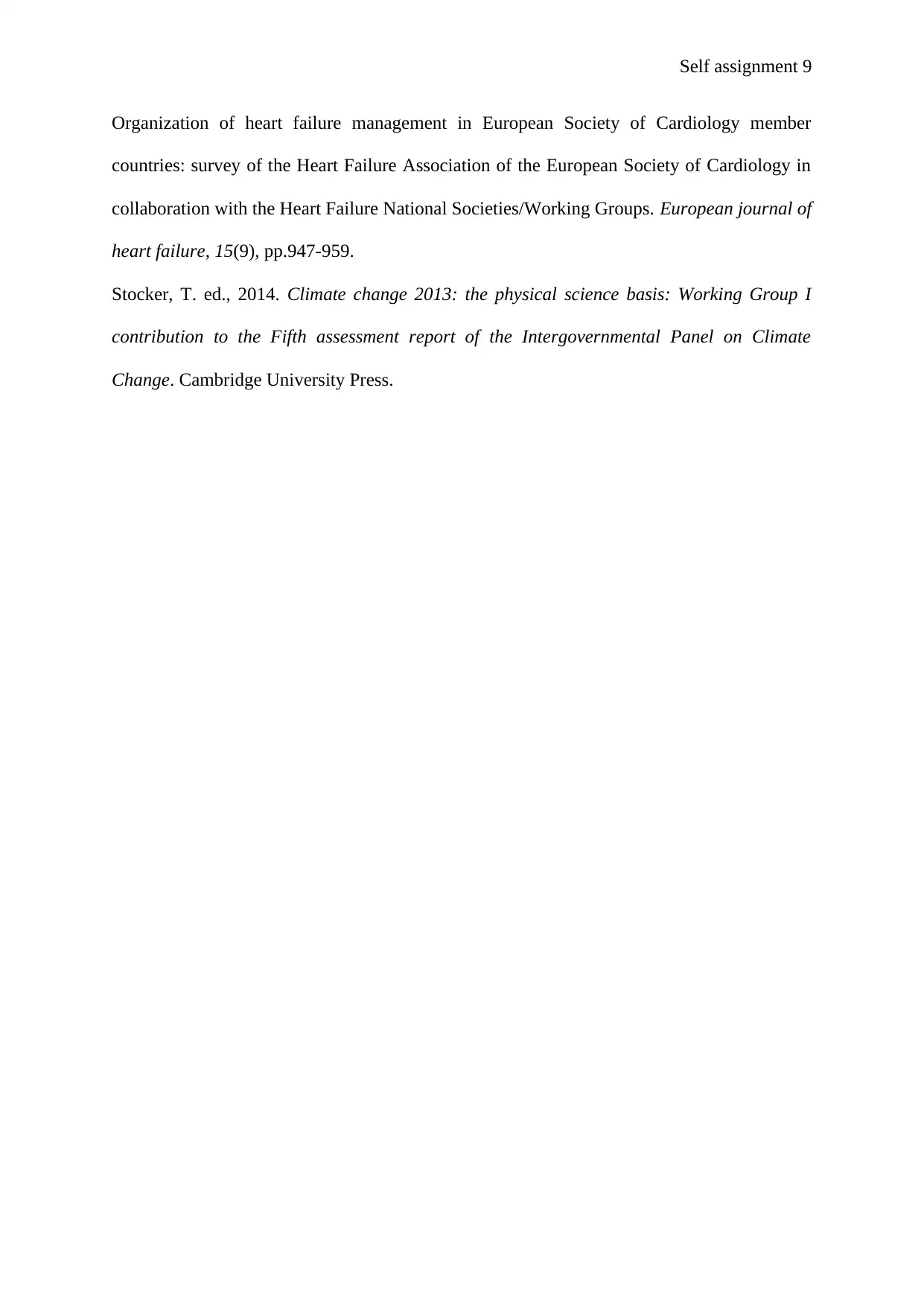
Self assignment 9
Organization of heart failure management in European Society of Cardiology member
countries: survey of the Heart Failure Association of the European Society of Cardiology in
collaboration with the Heart Failure National Societies/Working Groups. European journal of
heart failure, 15(9), pp.947-959.
Stocker, T. ed., 2014. Climate change 2013: the physical science basis: Working Group I
contribution to the Fifth assessment report of the Intergovernmental Panel on Climate
Change. Cambridge University Press.
Organization of heart failure management in European Society of Cardiology member
countries: survey of the Heart Failure Association of the European Society of Cardiology in
collaboration with the Heart Failure National Societies/Working Groups. European journal of
heart failure, 15(9), pp.947-959.
Stocker, T. ed., 2014. Climate change 2013: the physical science basis: Working Group I
contribution to the Fifth assessment report of the Intergovernmental Panel on Climate
Change. Cambridge University Press.
⊘ This is a preview!⊘
Do you want full access?
Subscribe today to unlock all pages.

Trusted by 1+ million students worldwide
1 out of 9
Related Documents
Your All-in-One AI-Powered Toolkit for Academic Success.
+13062052269
info@desklib.com
Available 24*7 on WhatsApp / Email
![[object Object]](/_next/static/media/star-bottom.7253800d.svg)
Unlock your academic potential
Copyright © 2020–2025 A2Z Services. All Rights Reserved. Developed and managed by ZUCOL.




